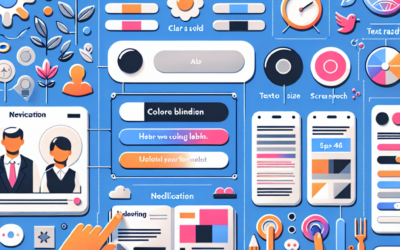Learn how to design for accessibility to create inclusive websites that enhance user experience and expand your audience reach.
Creating Web Experiences for All: The Essential Role of Inclusive Design in Today’s Digital Landscape
In the ever-evolving digital realm, inclusive design has emerged as a crucial element that prioritizes accessibility and usability for all users. Inclusive design transcends traditional design principles, recognizing the diverse needs of everyone, including people with disabilities. By adopting an inclusive approach, designers can create seamless experiences that resonate with a wider audience.
At the heart of inclusive design is empathy. Designers must place themselves in the shoes of various users, considering factors like age, mobility, and cognitive abilities. Incorporating elements such as screen reader compatibility, color contrast, and flexible layouts ensures that no one is left behind. For instance, incorporating accessible web design practices pays dividends by enhancing user experience.
Moreover, inclusive design can significantly impact local businesses. Companies that prioritize inclusive strategies often find themselves attracting more local customers. By optimizing their online platforms for ease of navigation and accessibility, businesses can engage with a broader audience and foster loyalty. Local SEO can substantially increase visibility, making it essential for businesses to implement effective local SEO strategies as part of their design process.
One compelling aspect of inclusive design is its alignment with ethical standards. In a world increasingly reliant on digital interaction, upholding the rights of all users is paramount. It’s not merely about compliance; it’s about creating an atmosphere of understanding and support. This dedication to inclusivity often shines through in great web design, characterized by user-centric principles. For designers looking to improve their skills, learning about user experience optimization can be invaluable.
As we advance further into the digital age, the significance of inclusive design will only grow. It challenges designers to think critically and become more aware of those who may not fit the typical user profile. By creating environments that prioritize accessibility, we can tear down barriers—both digital and societal. Ultimately, inclusive design not only enhances user satisfaction but also drives innovation, ensuring that every voice is heard in the conversation of digital design.
Accessibility Web Design for All Users
Learn how Accessibility Web Design creates inclusive online experiences for all users, enhances SEO, and improves overall website usability.
Accessible Website Design: Best Practices
Discover essential Accessible Website Design Best Practices to create inclusive web experiences, enhance usability, and improve search engine visibility.
Designing Accessible Websites: A Complete Guide
Learn how to create inclusive online experiences with our Designing Accessible Websites Guide. Enhance usability and reach a broader audience today!
How can I ensure accessibility in my WordPress design?
Learn how to enhance your site with Accessibility WordPress Design. Discover essential strategies to create an inclusive and user-friendly website for all.
Optimizing Accessible Web Design
Discover essential strategies for Optimizing Accessible Web Design to create inclusive websites that enhance user experience and comply with legal standards



